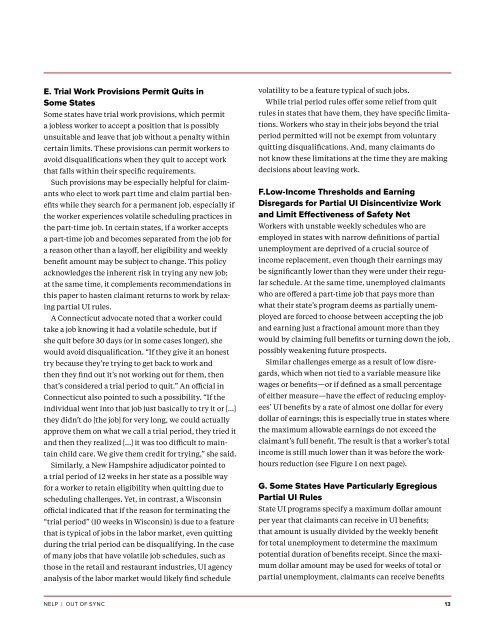Out of Sync
Out-of-Sync-Report
Out-of-Sync-Report
- No tags were found...
You also want an ePaper? Increase the reach of your titles
YUMPU automatically turns print PDFs into web optimized ePapers that Google loves.
E. Trial Work Provisions Permit Quits inSome StatesSome states have trial work provisions, which permita jobless worker to accept a position that is possiblyunsuitable and leave that job without a penalty withincertain limits. These provisions can permit workers toavoid disqualifications when they quit to accept workthat falls within their specific requirements.Such provisions may be especially helpful for claimantswho elect to work part time and claim partial benefitswhile they search for a permanent job, especially ifthe worker experiences volatile scheduling practices inthe part-time job. In certain states, if a worker acceptsa part-time job and becomes separated from the job fora reason other than a lay<strong>of</strong>f, her eligibility and weeklybenefit amount may be subject to change. This policyacknowledges the inherent risk in trying any new job;at the same time, it complements recommendations inthis paper to hasten claimant returns to work by relaxingpartial UI rules.A Connecticut advocate noted that a worker couldtake a job knowing it had a volatile schedule, but ifshe quit before 30 days (or in some cases longer), shewould avoid disqualification. “If they give it an honesttry because they’re trying to get back to work andthen they find out it’s not working out for them, thenthat’s considered a trial period to quit.” An <strong>of</strong>ficial inConnecticut also pointed to such a possibility. “If theindividual went into that job just basically to try it or […]they didn’t do [the job] for very long, we could actuallyapprove them on what we call a trial period, they tried itand then they realized […] it was too difficult to maintainchild care. We give them credit for trying,” she said.Similarly, a New Hampshire adjudicator pointed toa trial period <strong>of</strong> 12 weeks in her state as a possible wayfor a worker to retain eligibility when quitting due toscheduling challenges. Yet, in contrast, a Wisconsin<strong>of</strong>ficial indicated that if the reason for terminating the“trial period” (10 weeks in Wisconsin) is due to a featurethat is typical <strong>of</strong> jobs in the labor market, even quittingduring the trial period can be disqualifying. In the case<strong>of</strong> many jobs that have volatile job schedules, such asthose in the retail and restaurant industries, UI agencyanalysis <strong>of</strong> the labor market would likely find schedulevolatility to be a feature typical <strong>of</strong> such jobs.While trial period rules <strong>of</strong>fer some relief from quitrules in states that have them, they have specific limitations.Workers who stay in their jobs beyond the trialperiod permitted will not be exempt from voluntaryquitting disqualifications. And, many claimants donot know these limitations at the time they are makingdecisions about leaving work.F. Low-Income Thresholds and EarningDisregards for Partial UI Disincentivize Workand Limit Effectiveness <strong>of</strong> Safety NetWorkers with unstable weekly schedules who areemployed in states with narrow definitions <strong>of</strong> partialunemployment are deprived <strong>of</strong> a crucial source <strong>of</strong>income replacement, even though their earnings maybe significantly lower than they were under their regularschedule. At the same time, unemployed claimantswho are <strong>of</strong>fered a part-time job that pays more thanwhat their state’s program deems as partially unemployedare forced to choose between accepting the joband earning just a fractional amount more than theywould by claiming full benefits or turning down the job,possibly weakening future prospects.Similar challenges emerge as a result <strong>of</strong> low disregards,which when not tied to a variable measure likewages or benefits—or if defined as a small percentage<strong>of</strong> either measure—have the effect <strong>of</strong> reducing employees’UI benefits by a rate <strong>of</strong> almost one dollar for everydollar <strong>of</strong> earnings; this is especially true in states wherethe maximum allowable earnings do not exceed theclaimant’s full benefit. The result is that a worker’s totalincome is still much lower than it was before the workhoursreduction (see Figure 1 on next page).G. Some States Have Particularly EgregiousPartial UI RulesState UI programs specify a maximum dollar amountper year that claimants can receive in UI benefits;that amount is usually divided by the weekly benefitfor total unemployment to determine the maximumpotential duration <strong>of</strong> benefits receipt. Since the maximumdollar amount may be used for weeks <strong>of</strong> total orpartial unemployment, claimants can receive benefitsNELP | OUT OF SYNC 13


